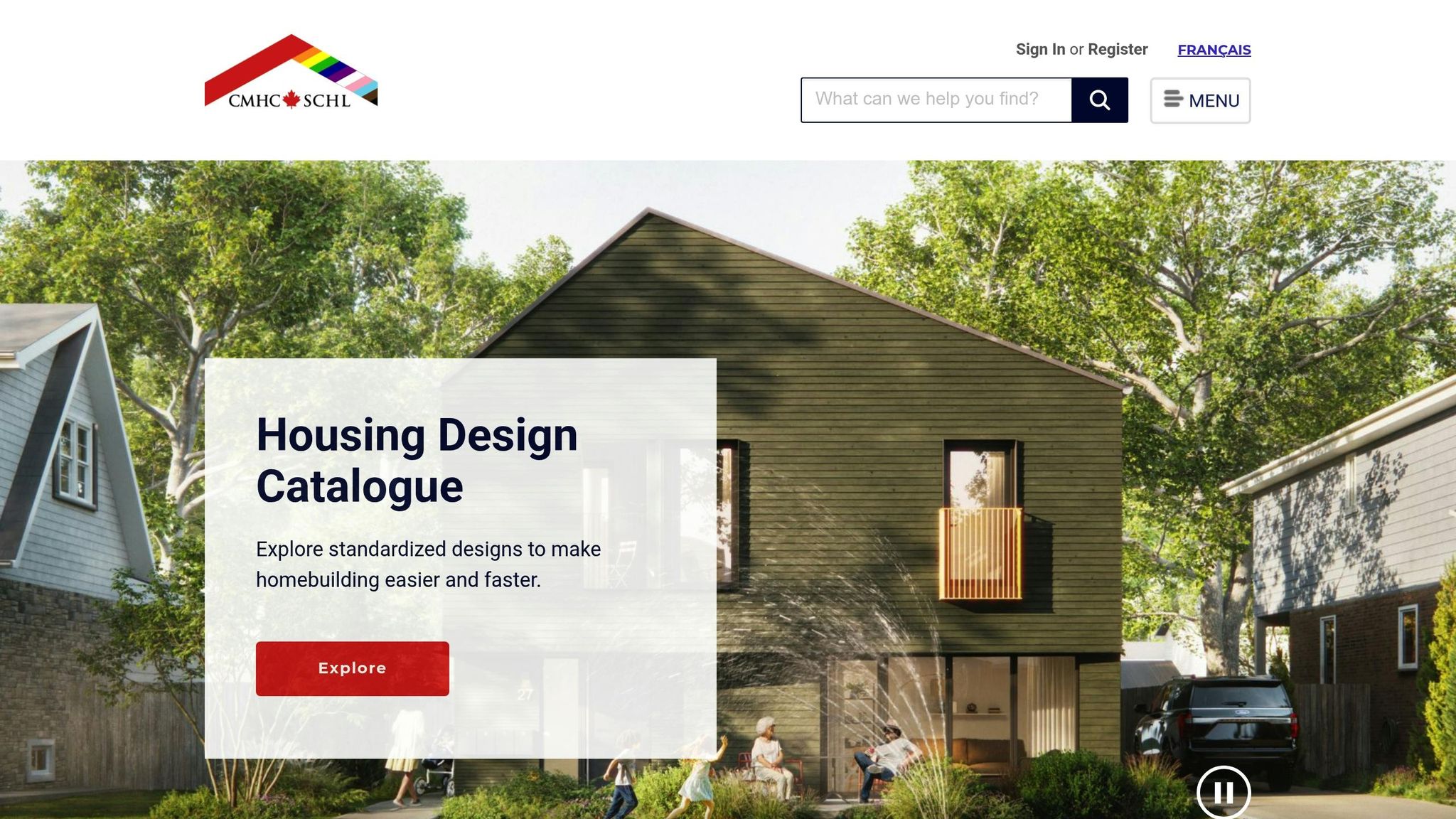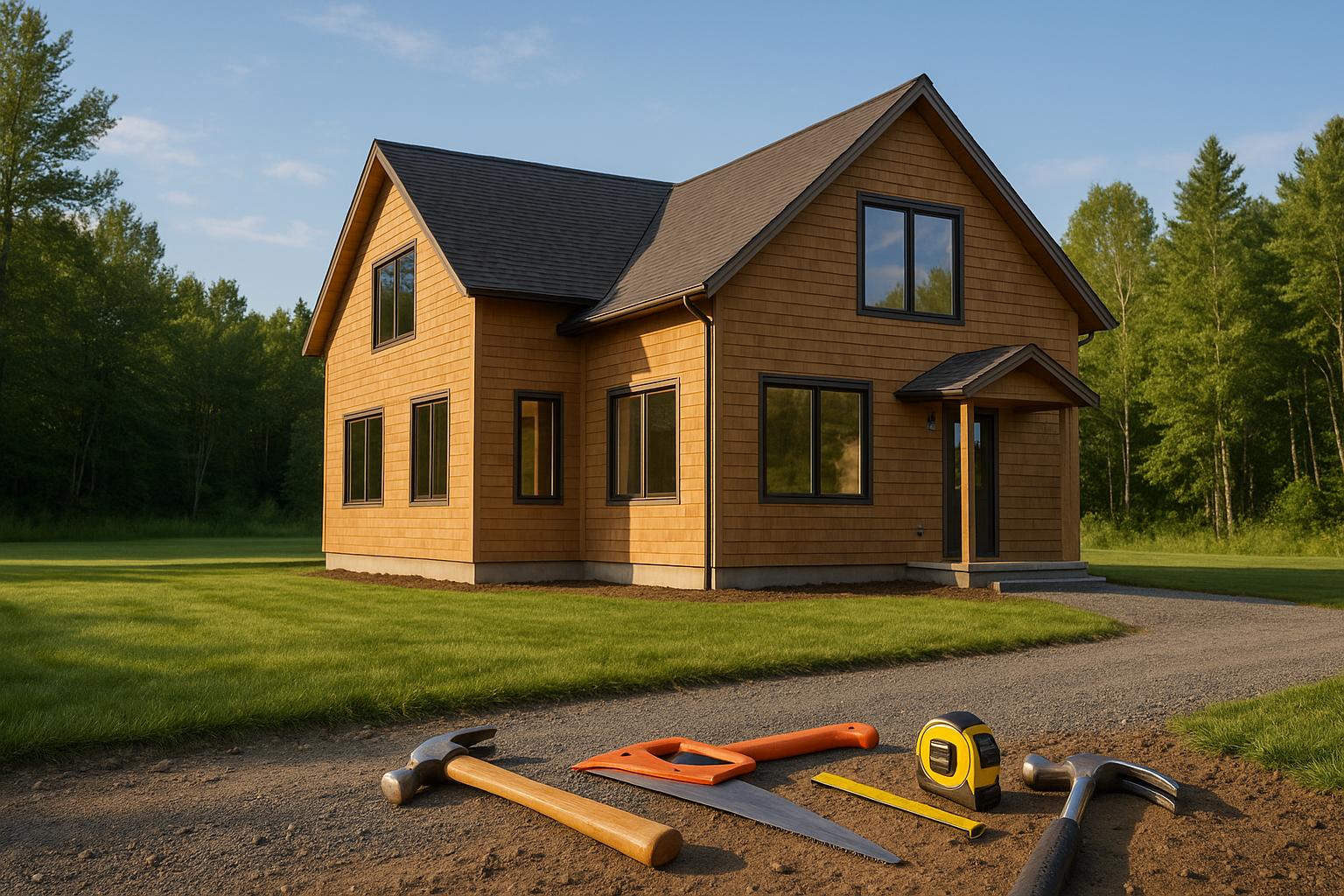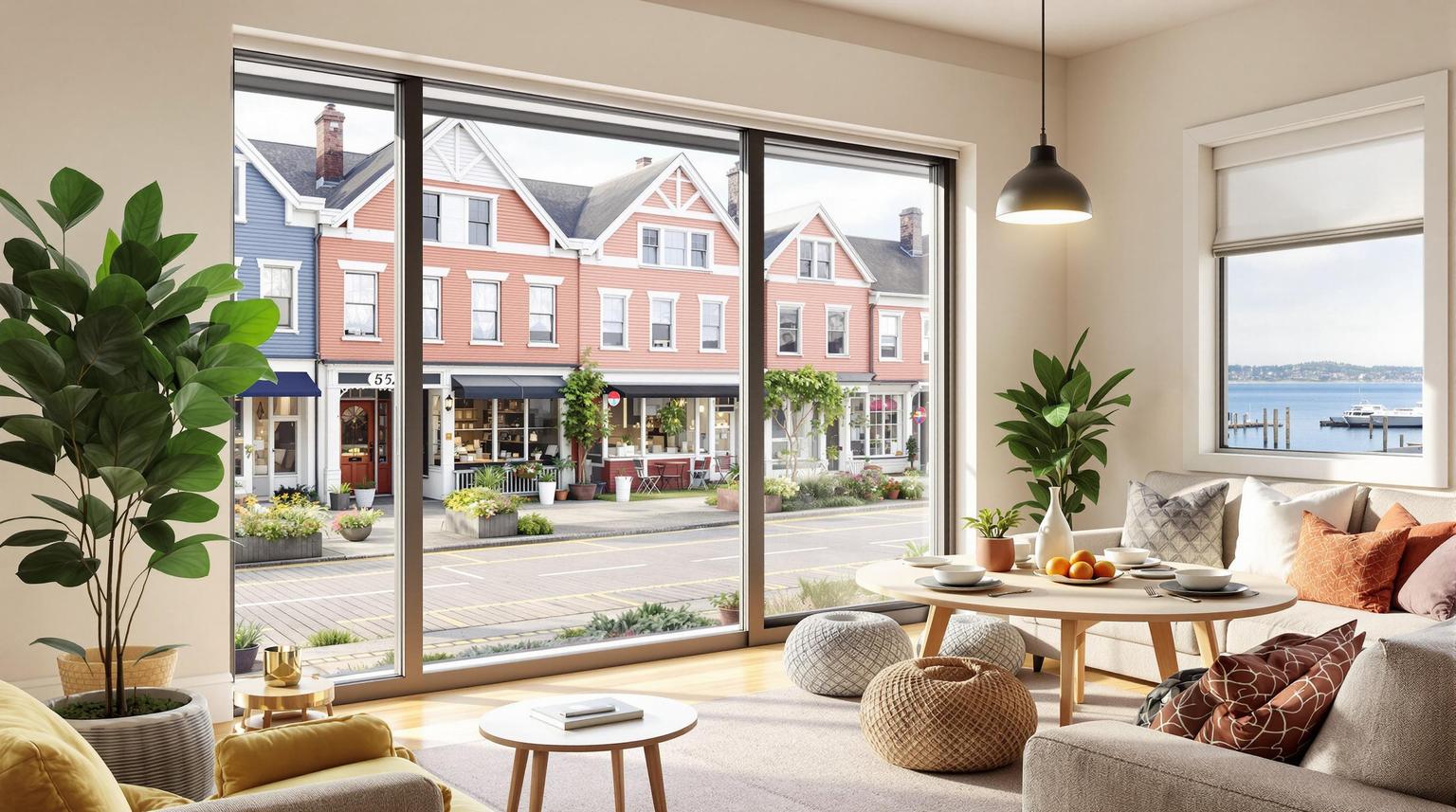Dartmouth’s new ER-3 zoning opens doors for property owners to create multi-generational housing, addressing housing shortages while offering financial opportunities. Under this zoning, properties can host up to 8 rental units with features like accessibility, no parking minimums, and proximity to transit and amenities. It’s a practical solution for families wanting to live close together while maintaining independence.
Key details:
- Lot size: Minimum 600 m² for up to 8 units.
- Design: Accessibility features, 11 m max height, and specific lot coverage rules.
- Financing: CMHC’s MLI Select program offers up to 95% financing for energy-efficient builds.
- Construction: Integrated design-build methods save time and money compared to fragmented approaches.
ER-3 zoning not only supports family needs but also helps meet Dartmouth’s housing goals while offering property owners a chance to capitalize on rental income.
Multi-Generational Housing Options Under ER-3
ER-3 zoning provides a framework for creating housing that brings multiple generations together while maintaining individual living spaces. This zoning allows property owners to explore various housing configurations that balance family closeness with independence.
Housing Types Allowed
Single-unit dwellings with secondary suites are a practical choice for multi-generational living. For example, a primary house paired with a separate backyard suite offers family members the chance to live independently while staying nearby.
Two-unit and three-unit dwellings cater to larger families. These setups enable different generations to occupy separate units within the same building, with the option to share common areas.
Townhouse developments allow for a more expansive approach, accommodating up to eight units within ER-3 zoning guidelines [1]. This design works well for extended families, offering proximity along with personal privacy.
Small shared housing is another option, where family members share communal spaces like kitchens and living rooms but retain private bedrooms and bathrooms.
ER-3 zoning's flexibility ensures that properties can adapt over time. A duplex built today can evolve to meet the changing needs of a growing family.
Design Requirements
To maintain harmony with existing neighbourhoods, ER-3 zoning includes specific design rules for multi-generational housing. For standard 1-4 unit dwellings, a minimum lot size of 325 square metres (3,498 square feet) is required [1].
For townhouse developments, the lot size requirements vary. End units must have at least 245 square metres (2,637 square feet), while interior units need 130 square metres (1,399 square feet) [1].
Building height is restricted to 11 metres (36 feet), which generally supports 2-3 storey structures [1].
Lot coverage is capped between 42% and 50% to preserve outdoor spaces. The required frontage is 10.7 metres (35.1 feet) for standard dwellings, while townhouse units need 9.1 metres (30 feet) for end units and 6.1 metres (20 feet) for interior units [1].
These design guidelines ensure that multi-generational housing remains functional and blends well with the surrounding community, offering adaptable solutions for families as their needs change over time.
Building Multi-Generational Properties: Integrated vs Fragmented Construction
When constructing multi-generational properties under ER-3 zoning, property owners face an important decision: Should they go with a fragmented or integrated design-build approach? This choice doesn’t just influence how smoothly the project runs - it also affects timelines, budgets, and the overall success of your rental property investment. Let’s explore why integrated design-build methods often deliver better results.
Fragmented vs Integrated Approaches
Fragmented construction involves hiring and coordinating multiple independent specialists - architects, engineers, contractors, electricians, plumbers, and more. Each professional works separately, following their own schedule and priorities. While this might seem straightforward at first, it often leads to miscommunication, delays, and hefty budget overruns - sometimes by as much as 30% to 60%.
Here’s the challenge: As the property owner, you’re stuck acting as the go-between. If an architect’s plans don’t align with an engineer’s specifications or if unexpected design changes are needed, it’s on you to resolve these conflicts. And when schedules don’t sync up, what was supposed to be an eight-month project can drag on for 18 months or more. For multi-generational properties, where rental income depends on timely completion, these delays can seriously hurt your return on investment.
Integrated design-build approaches take a different path. Instead of hiring multiple companies, you work with a single team. From day one, planners, architects, engineers, and construction crews collaborate under a unified system. This teamwork eliminates the coordination headaches that come with fragmented construction.
When issues arise, integrated teams resolve them internally, sparing you from technical disputes. The design and construction teams work together seamlessly, ensuring that potential problems are addressed early - before they become costly delays or budget surprises.
| Factor | Design-Build | Multiple Contractors |
|---|---|---|
| Budget Control | Fixed price, no overruns | Cost-plus with frequent overruns |
| Timeline Management | 6–8 months | 12–18 months |
| Communication | Single point of contact | Managing 6+ separate companies |
| Quality Assurance | Unified standards and warranty | Multiple warranties and standards |
| Problem Resolution | Internal coordination | External mediation required |
Benefits of Fixed-Price and Systematic Delivery
One of the standout advantages of the integrated approach is the use of fixed-price contracts, which eliminate the uncertainty that comes with fluctuating costs. Instead of hoping contractors stick to their estimates, you’ll know exactly what your project will cost from the start. This is especially important for ER-3 developments, where precise financial planning is crucial for securing financing and estimating rental income.
In contrast, cost-plus contracts can leave you vulnerable to unexpected expenses. Rising material prices, scope changes, and frequent adjustments can easily push your budget 30% to 60% higher than planned. Fixed-price agreements shift this risk to the construction company, ensuring your investment stays protected.
Guaranteed timelines are another major benefit. Integrated builders often offer timeline guarantees with financial penalties for delays - sometimes up to $1,000 per day. This accountability ensures your property is completed on schedule, allowing rental income to start flowing as planned. For example, a fourplex generating around $8,000 per month in rent could lose tens of thousands of dollars if construction drags on unnecessarily.
Systematic delivery is what makes these guarantees possible. Integrated teams coordinate every detail - material deliveries, inspections, and labour schedules - to keep the project moving efficiently. Unlike fragmented construction, where delays are common, this approach ensures steady progress.
Finally, single-point accountability simplifies your role as the property owner. Instead of juggling multiple contractors and trying to figure out who’s responsible for what, you deal with one team that oversees the entire project. If an issue arises, there’s no finger-pointing - just one call to the team managing everything.
For ER-3 developments, where timely completion is tied directly to rental income, the predictability of integrated design-build construction offers a clear financial edge. Faster project completion means rental income starts sooner, improving cash flow and boosting your overall return on investment.
Financing and Profitability for Multi-Generational Housing
Developing multi-generational properties under ER-3 zoning requires a solid initial investment, but with the right financing plan, you can significantly enhance cash flow and overall returns. ER-3 zoning not only offers design flexibility but also creates opportunities for financing and rental strategies that can transform your project into a profitable venture.
CMHC Financing Options

The Canada Mortgage and Housing Corporation (CMHC) offers an attractive financing program called MLI Select, which is tailored for energy-efficient multi-unit rental properties. This program aligns perfectly with ER-3 developments in Dartmouth. Through MLI Select, qualified property owners can access financing for up to 95% of the total project cost, dramatically reducing the upfront down payment. For instance, if you're building a fourplex with a construction cost of $800,000, the required 5% down payment would be around $40,000. Compare that to the typical 20% down payment - approximately $160,000 - and the difference is substantial. This translates to a leverage ratio of about 20:1.
To qualify, properties must exceed standard building code energy efficiency levels by at least 40%. Achieving this involves features like improved insulation, triple-pane windows, high-efficiency heat pumps, and advanced air sealing. While these upgrades add about $40,000 per unit - raising per-unit costs from $160,000 to $200,000 - the benefits of reduced financing requirements and improved cash flow make the additional investment worthwhile.
Another major advantage of MLI Select is the extended amortization period, which can go up to 50 years. This significantly reduces monthly payments, helping property owners achieve positive cash flow right from the start. Together, these financing features create a strong foundation for maximizing rental income.
Maximizing Rental Income
Once financing is in place, the next step is to focus on strategies that optimize rental income. Energy-efficient construction not only makes your property eligible for better financing but also appeals to tenants who appreciate lower utility bills and modern amenities. In Dartmouth, well-designed 2-bedroom units typically rent for $1,950 to $2,100 per month.
To further boost your property's appeal, consider offering a premium rental-ready package. This includes essentials like a full set of appliances, window coverings, and integrated smart home features, enabling tenants to move in immediately after construction is completed. While this adds roughly $15,000 per unit to your construction costs, the investment can justify higher rents and attract quality tenants who are likely to stay longer.
Adding smart home features - such as keyless entry systems and programmable thermostats - further enhances tenant experience by offering convenience and security. Additionally, design elements like ground-floor units, private entrances, and small outdoor spaces can make your property especially appealing to families, who often prefer these features and tend to stay longer, reducing turnover costs.
sbb-itb-16b8a48
Success Stories: Multi-Generational Housing Projects in Dartmouth
Examples from Dartmouth show how property owners are putting ER-3 zoning to work, building multi-generational housing that offers both financial gains and functional living spaces. These stories underline the advantages of streamlined, integrated construction methods.
Integrated Design-Build Project Results
Helio Urban Development has spearheaded several multi-generational housing projects across Nova Scotia, with many in Dartmouth benefiting from ER-3 zoning. Their integrated design-build approach has delivered impressive results, proving the value of a coordinated construction strategy.
Take their ongoing work on 31 units: Helio has avoided budget overruns entirely, a stark contrast to the typical industry trend of exceeding initial estimates by 30–60%. By offering fixed costs upfront, they eliminate financial surprises for property owners.
Timing is another area where Helio excels. Projects are consistently completed within just six months, allowing property owners to start collecting rental income on time. With units renting for $1,950–$2,100 per month, this reliability ensures no lost revenue due to delays.
Cost savings are also noteworthy. Helio’s integrated process has cut coordination waste, saving property owners an average of $47,000 compared to traditional construction methods. This is achieved by reducing inefficiencies like rework between teams.
Quality control is another strength of Helio’s approach. Their process includes five separate inspections by a Professional Engineer during construction, along with a final inspection chosen by the property owner. This rigorous oversight ensures high-quality results, backed by a two-year warranty on all work. These measures make systematic construction a go-to choice for property owners aiming for both precision and profitability.
Best Practices for Property Owners
Property owners who have successfully developed multi-generational housing under ER-3 zoning tend to follow a few tried-and-true strategies. These practices not only streamline construction but also boost long-term returns.
- Opt for fixed-price contracts. Locking in costs upfront removes financial uncertainty. Lloyd Liu, co-founder of Helio Urban Development, emphasizes the importance of fixed pricing and guaranteed timelines, which reflect the accountability property owners should expect.
- Focus on energy efficiency for better financing. Meeting CMHC MLI Select standards, which require 40% greater energy efficiency than standard codes, can unlock major financing benefits. While this adds about $40,000 per unit (raising costs from $160,000 to $200,000), it enables property owners to secure 95% financing with just a 5% down payment, creating immediate positive cash flow.
- Invest in rental-ready packages. Adding features like appliances, smart home technology, and window coverings - at an extra cost of around $15,000 per unit - ensures units are ready to rent as soon as construction wraps up. This avoids the typical 60-day delay in generating rental income.
- Request daily progress updates. Insisting on daily photo updates during construction allows property owners to stay informed and address issues early. Real-time project portals offered by top construction companies make this process seamless, reducing the need for constant site visits.
- Include guarantees for on-time delivery. Contracts with financial penalties for delays - sometimes as much as $1,000 per day - help ensure projects finish on schedule. This approach demonstrates a builder’s confidence in their ability to deliver and provides peace of mind for property owners.
These best practices make ER-3 multi-generational housing projects more predictable and profitable. By embracing systematic construction methods and these strategies, property owners can fully capitalise on the opportunities ER-3 zoning provides, leaving behind the unpredictability of traditional building approaches.
Conclusion: Multi-Generational Housing Potential with ER-3 Zoning
ER-3 zoning in Dartmouth opens up exciting possibilities for property owners looking to develop multi-generational, family-friendly housing. This zoning framework accommodates everything from fourplexes to larger rental properties, allowing owners to address the rising demand for affordable housing while securing solid financial returns.
The success of these projects, however, hinges on the construction approach. Traditional, fragmented construction methods - characterized by disjointed contractors, cost overruns, and delays - can derail timelines and drain profits. By contrast, integrated design-build methods streamline the process, removing inefficiencies and ensuring projects stay on track.
With fixed-price construction, owners gain cost certainty, and guaranteed timelines mean rental income begins flowing as planned. This structured approach reduces risks and turns potential setbacks into reliable returns.
While CMHC MLI Select financing may slightly raise per-unit construction costs, its high leverage potential ensures immediate cash flow, enabling property owners to build more units with the same capital. This financing strategy significantly boosts overall investment returns, underscoring the importance of precise and efficient project execution.
For those ready to dive into ER-3 multi-generational housing, focusing on accountability and reliability is critical. Seek out builders who back their promises with financial penalties for delays, provide regular progress updates, and stand behind their work with comprehensive warranties.
Dartmouth's ER-3 zoning lays the groundwork, but success depends on execution. Property owners who pair the zoning opportunities with efficient construction practices are well-positioned to tap into Nova Scotia's growing rental market. By combining strategic planning with diligent execution, they can turn multi-generational housing ideas into profitable, long-term investments.
FAQs
What are the advantages of using an integrated design-build approach for multi-generational housing under ER-3 zoning in Dartmouth?
An integrated design-build approach makes constructing multi-generational housing under ER-3 zoning much simpler by combining the design and construction phases into a single, cohesive process. This method offers fixed pricing, which means no surprise costs, and set timelines, reducing the delays often encountered with traditional building methods.
With one team handling everything, communication is more straightforward, and accountability is clear. This reduces confusion and keeps the project running smoothly. It’s an ideal fit for ER-3 projects, where the focus is on creating comfortable family living spaces while also maximizing rental income potential.
How does the CMHC MLI Select program help finance energy-efficient multi-generational housing in Dartmouth?
CMHC MLI Select Program: Supporting Energy-Efficient Housing in Dartmouth
The CMHC MLI Select program is designed to support energy-efficient multi-unit housing projects, offering property owners in Dartmouth a practical path to building sustainable, accessible homes for multiple generations. Through reduced premiums and favourable financing options, the program promotes housing developments that prioritize energy efficiency, affordability, and accessibility.
This initiative not only helps reduce upfront construction costs but also delivers long-term savings with energy-efficient designs. It's a smart option for those aiming to develop family-friendly rental properties or multi-generational homes within Dartmouth's ER-3 zoning framework.
What should property owners consider when designing multi-generational housing under ER-3 zoning in Dartmouth?
When designing multi-generational housing under ER-3 zoning in Dartmouth, it’s crucial to balance the needs of the community with zoning requirements. The design should reflect the character of the neighbourhood, paying close attention to elements like building height, setbacks, and architectural style. This helps ensure the new development fits naturally into its surroundings. For properties with five or more units, additional design standards come into play to maintain a balance between density and liveability.
ER-3 zoning also opens the door for higher-density housing on larger lots. For example, a 600-square-metre property can accommodate up to eight units, provided it meets the zoning criteria. It’s equally important to adhere to local planning regulations, which prioritize functional, family-friendly spaces that align with community design values. Thoughtful planning not only enhances rental income potential but also supports a cohesive and appealing neighbourhood environment.



